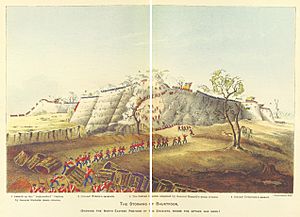Siege of Bharatpur facts for kids
Quick facts for kids Siege of Bharatpur |
|||||||
|---|---|---|---|---|---|---|---|
 An illustration of the siege |
|||||||
|
|||||||
| Belligerents | |||||||
| Commanders and leaders | |||||||
| Strength | |||||||
| 35,000 | 20,000 | ||||||
| Casualties and losses | |||||||
| 965 | 400 | ||||||
The siege of Bharatpur was a major battle that took place in a place called Bharatpur. This area is now part of Rajasthan, India. The battle happened between December 1825 and January 1826. British soldiers, led by Lord Combermere, surrounded the capital city. On January 18, 1826, they attacked and captured its strong fortress.
Why the Siege Happened
Bharatpur's Independence
For many years, Bharatpur had stayed free from British control. This was after they won a battle in 1805. The leaders of the East India Company (EIC) in London were not happy about this. The EIC was a powerful British trading company that also ruled parts of India.
Planning the Attack
In early 1825, the EIC leaders met. They wanted to know how to take control of Bharatpur. They asked the Duke of Wellington, a famous British general, for advice. He suggested Lord Combermere for the job. Even though some thought Combermere was not a "great genius," he was chosen.
Combermere Arrives in India
Lord Combermere sailed to Calcutta (now Kolkata) on an EIC ship. After a long journey, he arrived on October 2, 1825. He was ready to lead the British forces.
A New Ruler in Bharatpur
Meanwhile, the leader of Bharatpur, Baldeo Singh, passed away. His son, Balwant Singh, became the new Maharaja. Balwant Singh was only five years old. The British Governor-General of India, Lord Amherst, had officially recognized him as the new ruler.
A General's Decision
Before he died, Baldeo Singh had asked General Sir David Ochterlony to protect his young son. General Ochterlony decided to act on his own. He marched an army from the British base at Delhi towards Bharatpur. When Lord Amherst heard about this, he quickly ordered the troops to return. General Ochterlony then resigned from his position. After this, Lord Amherst appointed Combermere as the new Commander-in-Chief.
The Siege Begins
Combermere's Army
Lord Combermere's army was very large. It included two groups of foot soldiers (infantry). There was also a group of regular cavalry (soldiers on horseback). Plus, there was a group of irregular horsemen. The army had many large cannons for breaking down walls. They also had smaller field cannons. A special team of engineers and sappers (soldiers who dig tunnels and build defenses) were also part of the force.
Bharatpur's Strong Fortress
The fortress at Bharatpur was built by the Jat rulers. It had been made stronger over many years. By the time Combermere arrived, it was about 8 miles (13 km) around. It had 35 round towers made of clay and horse dung. These towers were baked hard by the sun, making them very tough. People thought the fortress could not be broken by cannons.
Fortress Defenses
The fortress also had a very wide and deep dry ditch around it. This ditch was about 150 feet (46 meters) wide and 59 feet (18 meters) deep. It could be filled with water from a nearby lake. This made it even harder to attack.
British Strategy
Combermere arrived in Agra on December 1, 1825. He reached Bharatpur on December 10. Right away, his troops were sent to capture a water reservoir. This reservoir was to the northwest of the fort. The goal was to stop the enemy from filling the ditch with water. This had happened during the 1805 siege.
The Final Attack
By mid-December, British forces had surrounded the fort. Small fights happened every day. The siege continued until the night of January 18. That night, the British made two holes in the fort walls. They also set off mines (explosives) to create more damage. Within two hours, the fort was attacked and captured.
What Happened Next
Lord Combermere's Reward
After his big success at Bharatpur, Lord Combermere was given a higher title. He became Viscount Combermere on February 8, 1827.
Sharing the Prize Money
After the siege, the money and valuables captured were divided. The officers decided to give £1,000 to the widows of each of the four European officers who died. They also gave £1,000 to be shared among the widows and orphans of the European soldiers who were killed.
The Bhurtpore Gun
For many years, a very large cannon called the 17.75-ton Bhurtpore gun stood outside the Royal Artillery Barracks in Woolwich, London. This gun was captured during the siege. Today, it is kept at the Royal Artillery Museum in Larkhill, Wiltshire.


